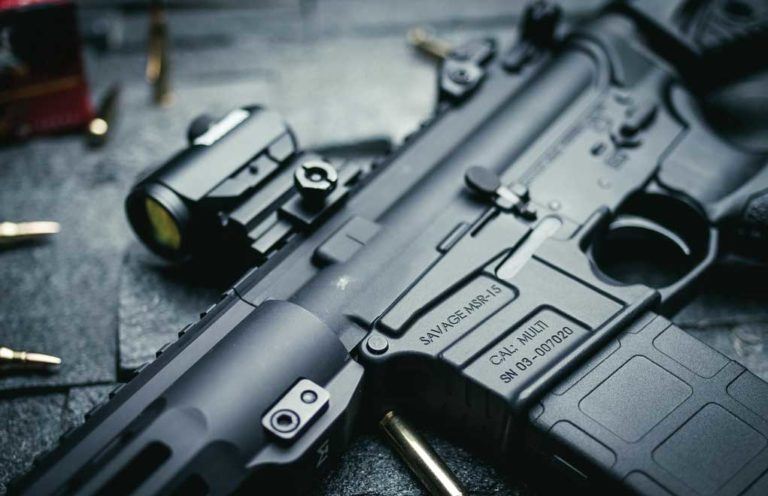
Light, compact, manageable and accurate, the AR-15 for home defense has all comers beat hands down.
Why an AR-15 for home defense is the smart choice:
- At around 7 pounds it's maneuverable.
- The controls — safety, mag release, trigger — are intuitively positioned.
- Low recoil makes mastering form and control easier.
- Rails allow easy mounting of lights, lasers and optics.
- 55-grain FMJ is ideal and cheap home defense ammo.
- The round will yaw or tumble when it impacts at close range.
- 20- to 30-round capacity ensure superior firepower.
- The manual of arms is simple.
- They are as or more affordable as other options.
Handguns are handy. Shotguns are powerful. But when it comes to the defense of one’s castle, the most versatile tool, besides a Secret Service detail assigned to you, is the AR-15.
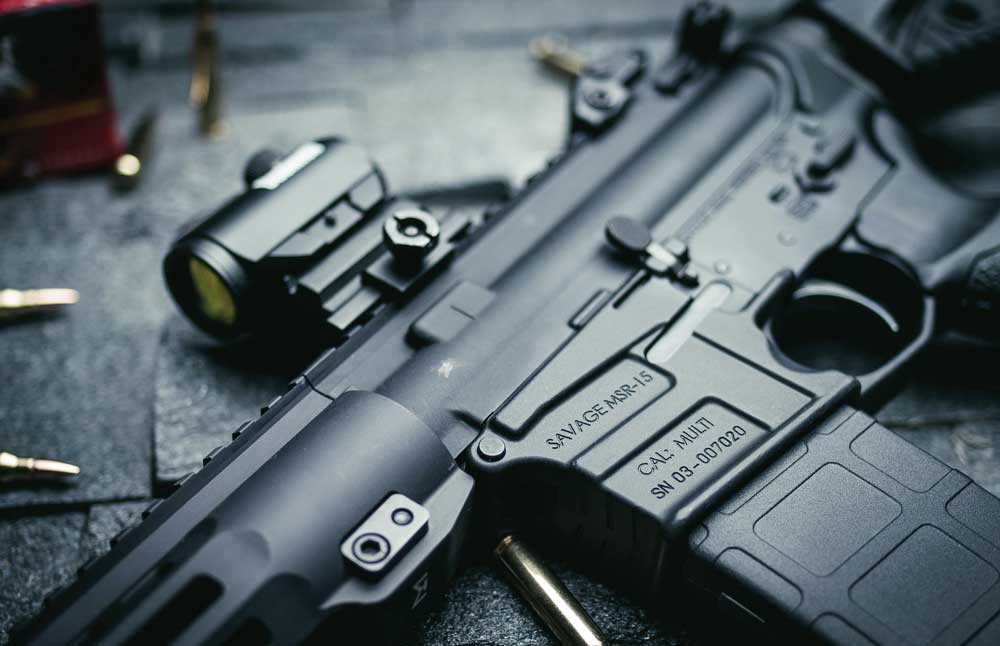
Why? Simple: It’s light and compact, has low recoil and great accuracy, and can be configured any way you wish. But first, let’s dispense with some of the canards that AR-15 detractors will raise: penetration, appearance and noise.
No, the .223 Rem./5.56 NATO will not shoot through a building. In fact, on interior walls it has less penetration than that of common handgun cartridges, even when those feature JHP bullets. Unless you’re using bonded rifle bullets designed to maintain structural integrity, the bullets of a .223 Rem./5.56 NATO cartridge will yaw in drywall, break apart and not over-penetrate. Oh, they’ll go through a wall or two, but not like a handgun.
A friend of mine is the head honcho of a multi-city SWAT team. His team once had the chance to “test” a neighborhood of houses before they were torn down. They shot every house with everything they could think of. “Patrick, every single handgun bullet left the test buildings, unless it hit a pipe or the building was brick.” The .223 Rem./5.56 NATO bullets commonly would enter the second room, but not leave that for the third room. The lesson for us all is simple: Everything is a hazard to the next room, but the .223/5.56 is less so past that.
The AR-15 is the current poster child for eeeevil gunz. Some will advise you use something less “aggressive” looking in order to make your legal situation less of a problem afterward. The bad guys can be called Problem One. The legal gauntlet can be called Problem Two.
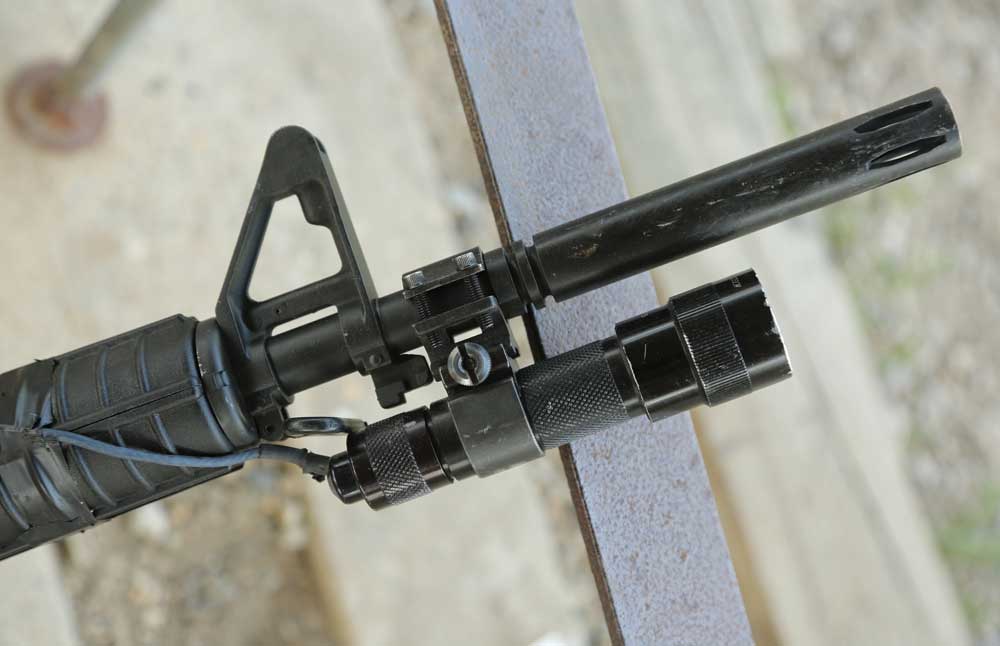
Here’s the catch: If you know the law, and you observe the law, and you don’t talk to anyone until your attorney is on hand, then Problem One can be solved. It can be solved in a lawful, moral, safe manner, which then makes the difficulties of Problem Two pretty much not. On the other hand, if you do something stupid, or unlawful, or unwise, you will have legal problems regardless of what firearm you use.
Then there’s noise. Here I have to begrudgingly admit there is some basis for concern. The muzzle blast of a rifle indoors is more than impressive — it can be deafening. However, the magnitude of that noise beyond that of a handgun or a shotgun is not that much. Yes, it’s more, but it isn’t like the other two are exactly quiet.
And, you can mitigate the noise. A suppressor may be a step too far (cost, paperwork, really making the prosecutor salivate), but there are other steps. First, not all rifle ammo is the same. A few practice sessions at an indoor range or on a covered firing line will tell you which loads are more or less noisy. (Test with hearing protection on, please.)
You can also use a Noveske KX3, a blast diverter that redirects the noise away from you without being a suppressor. You can also opt for less-noisy cartridges. An AR-15 in 9mm or .300 Blackout, with subsonic ammunition, for example, is markedly quieter than the same-size carbine chambered in .223 Rem./5.56 NATO.
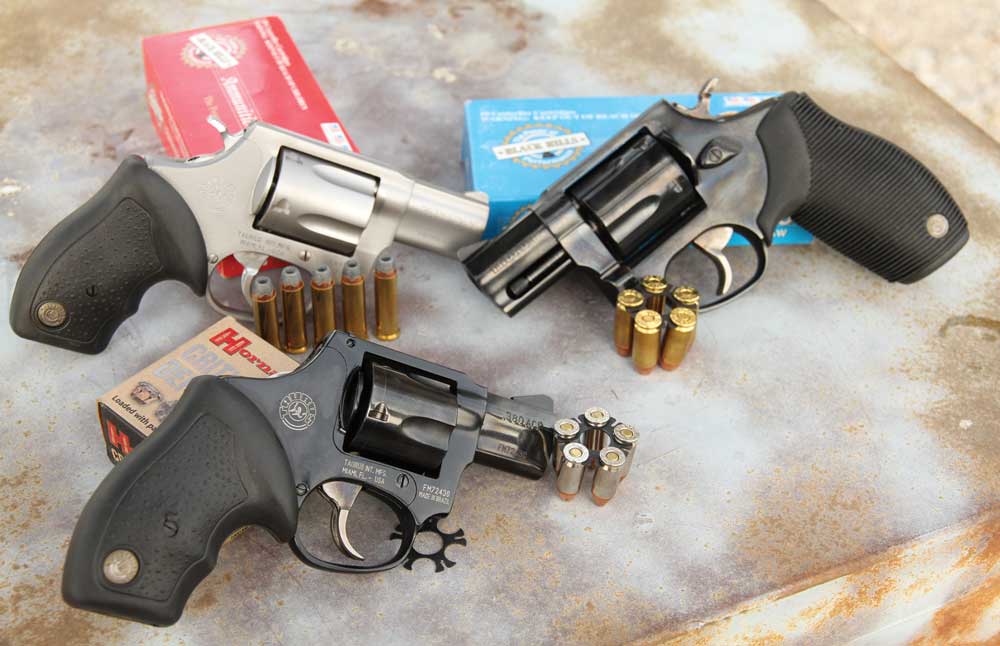
However, noise can be your friend. If you shoot, the bad guy or guys are on the other end of the noisy tool you’re using, and this can matter. In the Miami shootout with Platt and Mattix, the FBI agents remarked on the difference between the “pop-pop” of their handguns and the much louder .223 Rem. rifle being used against them. That difference now aids you — and not the bad guys.
So, with those out of the way, let’s look at why the AR-15 should be your first choice for protecting you and your loved ones in your home.
Weight And Ergonomics
A “heavy,” standard AR carbine tips the scales at just over 7 pounds. That’s heavy enough to control recoil, but it’s also light enough to not be a hindrance. Almost anyone can heft an AR, and in the ergonomics department — safety location, trigger press, adjustable stock and overall shooter fit — it gets top marks. Even a compact shotgun can be a bit cumbersome, and if you haven’t practiced pumping it, even the “ultra-reliable” pump shotgun can let you down.
An AR-15 with a red-dot becomes even handier. Explaining it to a new shooter is easy: “Put the dot where you want the bullet to go, and press the trigger.” Iron sights are less so, and shooting a shotgun with just a bead on the barrel becomes an arcane episode of divining impact.
Handguns? Hitting with a handgun takes a lot more practice than hitting with a rifle, especially one like the AR.
Light Recoil
Ever watch a new shooter the first time they shoot a handgun that’s too much for them? Or a shotgun? Right there, you can see them deciding: Is this for me, or not?
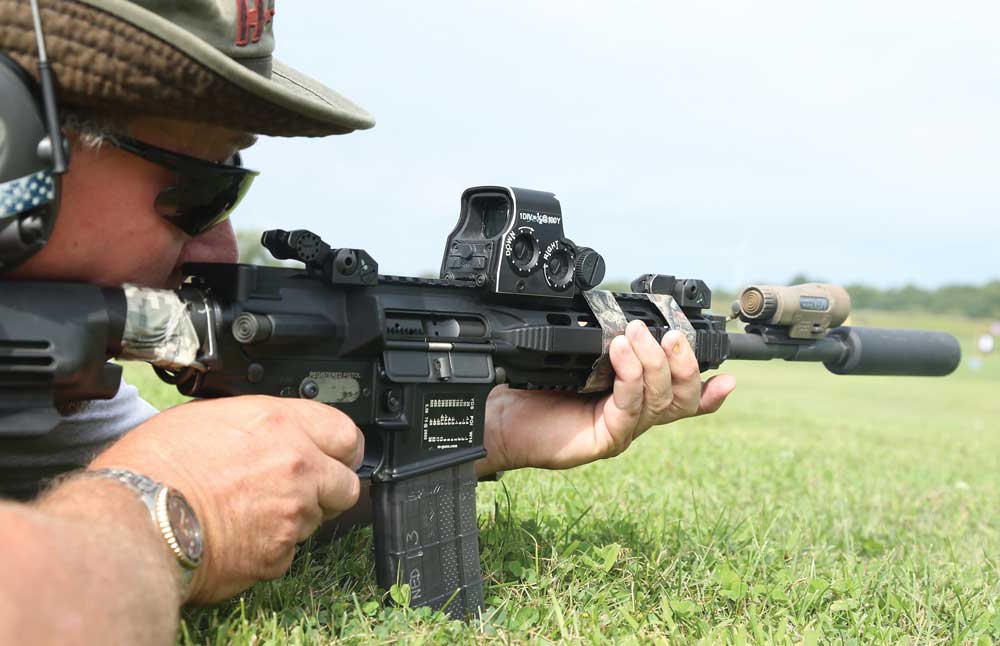
The much lower recoil of the AR-15 makes it possible to teach form and control, and not have recoil as a hindrance. And when the chips are down, low recoil is an asset to solving Problem One. The low recoil of the AR-15 means odd positions are not such a problem. Ever try to pump a shotgun while shooting prone? Good luck with that.
Extras — Or Essentials
It used to be a lot harder to mount lights or lasers on firearms. With the proliferation of rails, we now have many choices. Well, shotguns still lag a bit, but handguns can be on-par with ARs. Except, if you want a rail on a handgun, it has to come from the factory with one. Adding one later isn’t an option.
You can add a laser with laser-equipped grips, but handguns still fall behind ARs in this. On an AR-15, if yours lacks rails, it is as simple as swapping out the handguards for a set that has rails built in. And many ARs now come with railed handguards, or handguards that readily accept rail segments.
More than being able to mount lights or lasers, being able to use them gives the definitive nod to the AR-15. With one hand to hold the pistol grip and the other to hold up the rifle and aim, the task of also switching a light or laser on is relatively easy. On a handgun, with both hands right there — and not as much to hold onto — turning on lights or lasers is less easy. Shotguns pose a special situation, as there just aren’t as many options for mounting lights.
Defensive Ammunition
The easy choice for the AR-15 for home defense may surprise you: plain old 55-grain FMJ. Yes, nothing special. Except, it is. At inside-the-house distances, the 55-grain FMJ has not had time to “settle down.” When a bullet is fired, it gets sent down the bore and is spun by the rifling. There, it’s forced to rotate around its center of form.

When it leaves the muzzle, it has to adjust to rotating around its center of mass. During that transition, it is particularly susceptible to outside forces. If it strikes an object or target, the bullet will yaw, or tumble. Since you are in-close, it will be doing so with pretty much all of its velocity, and this can lead to impressive results.
You may have heard of soldiers in Iraq and Afghanistan being unimpressed with the performance of the 5.56 NATO. This is due to the bullet they use, the M855, and the distance. The much faster twist of the M4/M16 (one turn in 7 inches) creates more stabilization in the bullet. This means less yaw, especially at distance. And at distance, it has less velocity, so any yaw it does have will not be as effective as up close.
At close range, the 55 FMJ is a stout tool, and the same attribute that increases wounding also decreases over-penetration in walls, as we discussed earlier in the article.
Selecting An AR-15 For Home Defense
So, a relatively plain AR-15, of the type commonly referred to as an “M4gery,” can be just the ticket. With a 16-inch barrel, an adjustable stock, a red-dot sight and a light on it, the full-up, loaded weight is not going to be much, if any, past 8 pounds. Add a sling for extra versatility, and you’ve put on a few more ounces.

Now you have a compact, lightweight, easy-to-handle carbine, one that holds twenty or thirty rounds. It’s capable of tack-driving accuracy at home defense distances, with low felt recoil. Ammunition is common, easy to find and easy to load. The manual of arms — the handling methods — of the AR-15 are simple and straight-forward, and easy to learn.
And here’s another advantage the AR has, along with the shotgun: learners are less likely to inadvertently point the muzzle in a direction you do not want them to. New shooters with handguns can be a particular problem. It’s so easy to point a handgun “just anywhere” that a new shooter can be “sweeping” or pointing the firearm at themselves or others without realizing it. It can take some work to instill good habits. A long-gun, like a rifle or a shotgun, is long enough that muzzle direction is less likely to be inadvertent, and it’s easier to teach safe habits to new shooters.
As a final bonus, with the current marketplace dynamics, a vanilla-plain AR-15 can be had for the same as, or perhaps a small amount more than, a good-quality 9mm handgun. You don’t have to spend three or four mortgage payments to have a good AR-15.
Editor's Note: This article originally appeared in the May issue of Gun Digest the Magazine.

Next Step: Get your FREE Printable Target Pack
Enhance your shooting precision with our 62 MOA Targets, perfect for rifles and handguns. Crafted in collaboration with Storm Tactical for accuracy and versatility.
Subscribe to the Gun Digest email newsletter and get your downloadable target pack sent straight to your inbox. Stay updated with the latest firearms info in the industry.

![Best Concealed Carry Guns In 2025 [Field Tested] Wilson Combat EDC X9S 1](https://gundigest.com/wp-content/uploads/Wilson-Combat-EDC-X9S-1-324x160.jpg)


![Best 9mm Carbine: Affordable PCCs [Tested] Ruger Carbine Shooting](https://gundigest.com/wp-content/uploads/Ruger-Carbine-Shooting-100x70.jpg)
![Best AR-15: Top Options Available Today [Field Tested] Harrington and Richardson PSA XM177E2 feature](https://gundigest.com/wp-content/uploads/Harrington-and-Richardson-PSA-XM177E2-feature-100x70.jpg)

I agree with most of this article, but I do have two problems with it. First, thought Stag Arms took care of my lefty issue long ago, I’m still among those trapped behind enemy lines, so to speak. In the PRK, any advantage the AR may have over shotguns and lever actions is negated by the emasculated condition of the ‘featureless’ rifles available to us. There are options, however. The Mini 14 is the obvious one. The other is the Vz58. While it is a 7.62×39, all models, including the California legal version, are equipped for rapid and efficient reloads with stripper clips, and unlike any other modern autoloader, it can be topped up with loose rounds without removing the magazine. That could be a plus in certain situations.
Second, 5.56×45 55 Gr. ball got its reputation for massive wounds from the 1/14 twist barrels used on the original M16. That twist rate barely stabilizes the bullet, causing it to tumble as soon as it hits anything. From 1/12 or faster barrels, this bullet will punch little pencil holes.